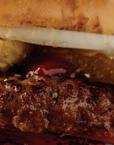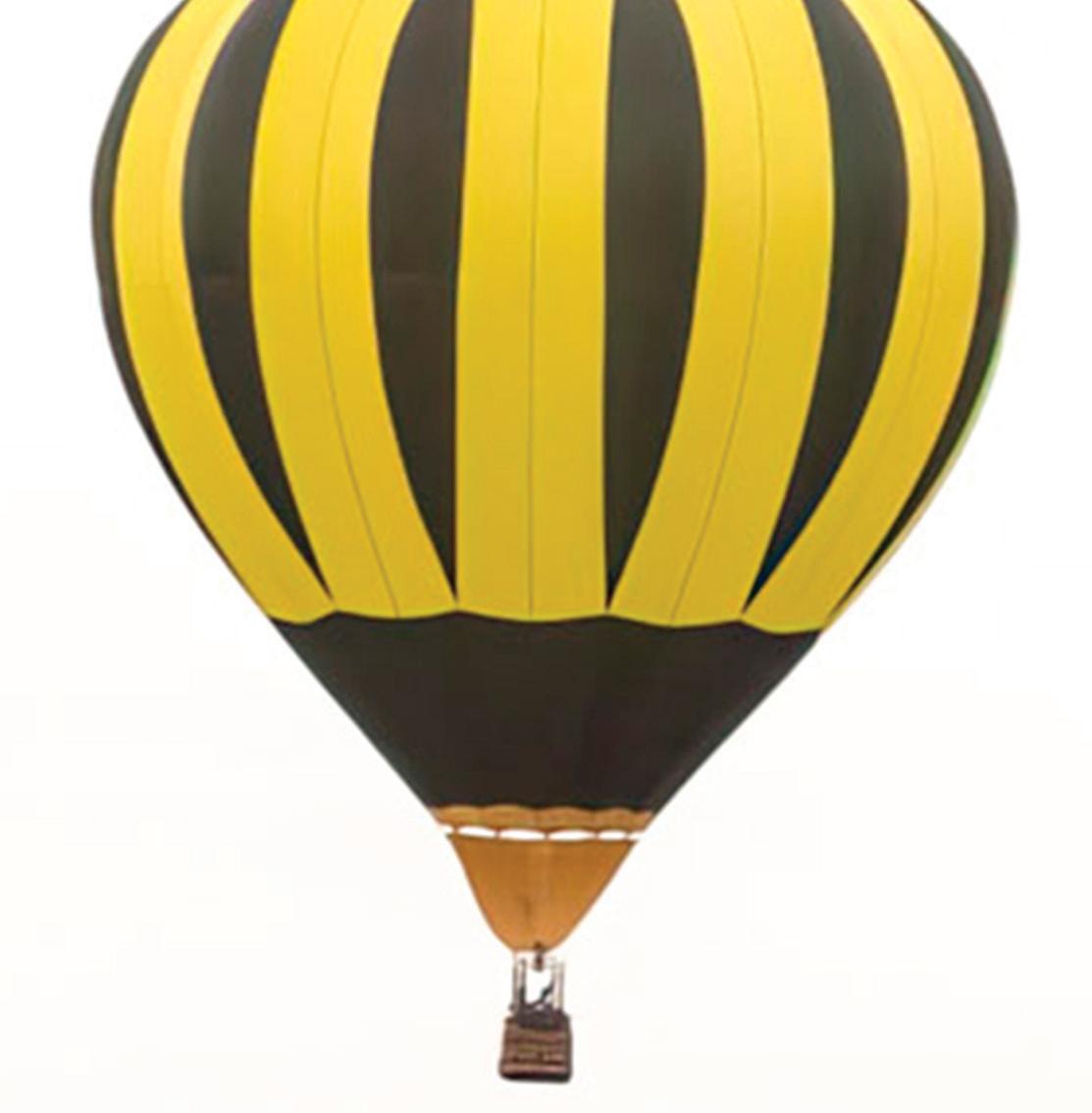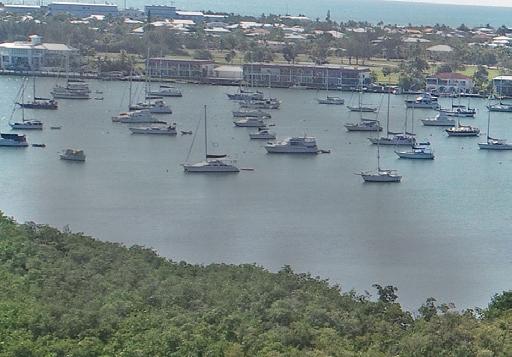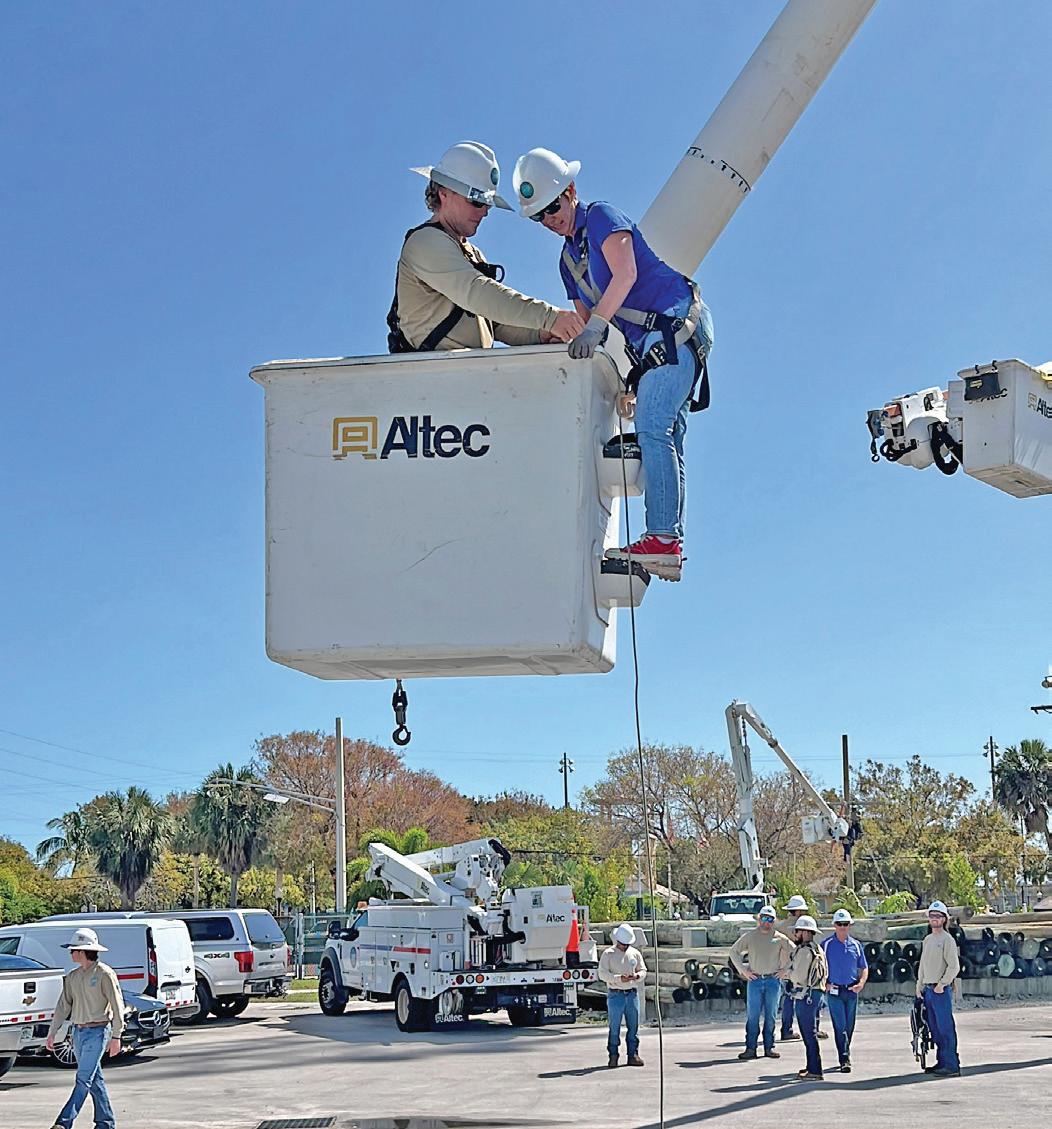Florida Currents

































May 2024 • Volume 13, No. 7
CEO Michael Shepard
VICE PRESIDENT OF CONTENT Leon Espinoza
EDITORIAL DIRECTOR Mike Teegarden, CCC
DEPUTY EDITORIAL DIRECTOR
Noble Sprayberry
SENIOR EDITOR Jennifer Paton, CCC
FLORIDA CURRENTS EDITORS
Chasity Anderson, CCC Valeri Pearon
ASSISTANT EDITORS Victoria Hampton, CCC; David Herder, CCC
ASSOCIATE EDITOR
Nina Todea
PUBLICATIONS PRODUCTION
SENIOR MANAGER
Elizabeth Beatty
PUBLICATIONS COORDINATOR
Alyssa McDougle
Members acknowledge that $4.31 a year, plus postage, is the cost to publish 12 issues a year of FLORIDA CURRENTS ISSN 23276304 (USPS 8300). Published by Pioneer Utility Resources Inc., 5625 NE Elam Young Pkwy. Ste. 100, Hillsboro, OR 97124—a not-for-profit Oregon cooperative corporation—the magazine serves the communication needs of consumerowned electric utilities in Florida. Preferred Periodicals postage paid at Hillsboro, OR 97123 and at additional mailing offices.
Postmaster: Send address changes to 5625 NE Elam Young Pkwy., Ste. 100, Hillsboro, OR 97124-6422.
HOW TO CONTACT FLORIDA CURRENTS
Subscription services:
Nonmember subscriptions $15 U.S. a year; $25 foreign a year. Prepayment required. Allow 4-8 weeks for first issue. Identify local edition desired. Have a problem receiving your magazine? Utility members should contact their utility office. Nonmembers call 503-357-2105 or email mailingdept@pioneer.coop.
Back issues:
Back issues and extra copies are $3 each, prepayment required. Supply is limited. Identify edition, month and year. Call first to check availability. Contact Pioneer Utility Resources: P.O. Box 1306, North Plains, OR 97133-1306; 503-357-2105; email: mailingdept@pioneer.coop.
DISPLAY ADVERTISING INQUIRIES
American MainStreet Publications 611 S. Congress Ave. Ste. 504 Austin, TX 78704-1714; 800-626-1181 or 512-441-5200; amp.coop.
© 2024 Pioneer Utility Resources. All rights reserved. Reproduction in whole or in part without written permission is prohibited. Direct reprint requests to editor@floridacurrents.com or for more information, visit www.pioneer.coop.
Central A/C Rebate
30% up to $500 – SEER2 15.3 or more
Ductless Mini Split A/C Rebate 30% up to $400 – SEER 18 or more
Room A/C Rebate
30% up to $100 – EER2 11 or more
Insulation Rebate
30% up to $300

Window Film or Solar Screen Rebate 100% up to $200
Caulk/Weatherstripping Rebate 100% up to $100
Cool/Reflective Roof Coating Rebate $25 per 5-gallon bucket





Vehicle Charger UL-certified Level 2 (up to $350)








FLORIDA KEYS ELECTRIC COOPERATIVE ASSOCIATION, INC.
Member Owned Since 1940
Karl Wagner
District 4, Marathon, President
Michael H. Puto
District 4, Marathon, Vice President
Cale Smith
District 3, Islamorada, Treasurer
Gretchen Holland
District 1, Key Largo, Secretary
James J. Boilini
District 1, Key Largo
David C. Ritz
District 1, Key Largo
Craig Belcher
District 2, Tavernier
Joseph H. Roth III
District 2, Tavernier
George D. Hertel
District 3, Islamorada
CONTACT US:
305-852-2431 | 800-858-8845
Pay by Phone 1-855-385-9912 www.FKEC.com
Mailing Address:
P.O. Box 377, Tavernier, FL 33070
MEMBERS SHOULD KNOW:
FKEC live-streams weather cams from our Tavernier and Marathon offices. Check out the views and real-time weather data at www.fkec.com/resources/liveweather-cams/
Florida Keys Electric Cooperative prioritizes safety training for our field crews, conducting an annual day-long session dedicated to practicing safety protocols and rescue techniques. Traditionally, this day serves as an opportunity for field crews to bond and refine their skills. However, this year, we decided to broaden the scope by inviting office employees to join in.
The objective was to foster unity by allowing in-house staff to gain firsthand experience of the work performed by our linemen, tree crew members, apprentices, and electricians, along with the safety measures involved. I am proud of the overwhelmingly positive reception and the exceptional teamwork demonstrated by everyone involved.
Participants were divided into groups comprising both field crews and office personnel from various departments. These groups rotated through five training stations, providing insights into different aspects of our operations and safety. While office employees couldn’t partake in all activities, they were given the option to go up 130 feet in our new highline truck. They also learned about confined spaces safety, pole top rescue, and could harness up and try the bucket bailout.
Raymond Turner, FKEC’s Director of Safety, described the day as highly collaborative, with field crews enthusiastically explaining the gear, equipment, and skills involved in their tasks. Office


SCOTT NEWBERRY Chief Executive Officer
staff members were equally eager to learn from the demonstrations and familiarize themselves with the equipment.
With approximately 115 employees based out of our two offices in Tavernier and Marathon, some rarely cross paths or get a glimpse into tasks outside their roles. Looking ahead, we aim to take proactive steps to bridge this gap, enhance overall company knowledge, and further foster camaraderie.
While not all employees were able to participate in this event, we plan to organize more activities like this in the future, ensuring that every FKEC team member has the opportunity to engage in hands-on field activities.
FKEC employees from across various departments share a day of safety training and camaraderie. Read the full story on page 4.









Mike Robinson with support on the ground from Crew Leader Juan Castano, practice climbing a pole to carefully lower an injured lineman to the ground as quickly and safely as possible.








FKEC earns Tree Line USA recognition for proper community forest management for 15th consecutive year.
For the 15th year in a row, the Arbor Day Foundation named Florida Keys Electric Cooperative a Tree Line USA utility to recognize FKEC’s dedication to proper community forest management in the Upper and Middle Keys.
Tree Line USA, a partnership between the Arbor Day Foundation and the National Association of State Foresters, recognizes public and private utilities for pursuing best practices that protect and cultivate America’s urban tree canopy. In addition, Tree Line USA promotes delivering safe and reliable electricity while maintaining healthy community forests.
“Trees are essential to creating more urban green spaces in communities across the United States,” said Dan Lambe, chief executive of the Arbor Day Foundation. “They also provide important benefits to residents, including
clean air, clean water, and vital tree shade. Service providers like Florida Keys Electric Cooperative demonstrate how easily trees and utilities can co-exist for the benefit of communities and residents.”
By joining the Tree Line USA program, service providers benefit from lowering line clearance costs due to proper pruning. As a result of those properly pruned and maintained trees, the member benefit from increased service reliability because those trees will have healthy root systems that decay less, have less structural weakness, and ultimately result in fewer downed lines during storms.
FKEC achieved the Tree Line USA recognition by meeting five program standards: quality tree care, annual worker training, tree planting and public education, formal tree-based
energy conservation, and a sponsorship of or participation in the Arbor Day celebration.
“Our FKEC tree crews and contractors are dedicated to going the extra mile to ensure tree health when maintaining line clearance,” said FKEC Environmental Manager Sara Hamilton. “We also take pride in sharing knowledge about the importance of trees, particularly native species, through annual community outreach programs such as our EnergySaving Native Tree Giveaway and Seeds for Students celebrating Florida Arbor Day.”
More information about Tree Line USA can be found at arborday.org/ TreeLineUSA. To learn more about FKEC, visit www.FKEC.com.
While FKEC implements an aggressive vegetation management program, we ask our members to help prevent outages by planting the right tree the right distance from power equipment.
It is critical to consider the mature
height and growth rate of a tree before you, or your landscaper, do any planting. By following proper planting distance guidelines, you can successfully landscape your yard without threatening power service to your home or surrounding area.
Planting trees, particularly palms and large canopy trees, too close to power equipment is an increasing problem in FKEC’s service territory. On a calm day, vegetation growing too close to power equipment may not look like it poses a threat, but in windy weather, limbs and palm fronds can make contact with electrical lines causing dangerous sparking and power outages.
In higher winds, such as a Category 1 Hurricane, a tree with a 3-5 foot tall trunk, will bend laterally by one foot. The taller the tree’s trunk the more potential lateral movement. Living in the Florida Keys, we know we will experience a storm or high winds at some point. So please consider the wind factor (see below) and follow the setback guidelines
before you do any planting.
FKEC works year-round implementing a comprehensive vegetation management program to prevent outages caused by trees. However, the most effective way to protect our local vegetation and maintain reliable power service starts with our FKEC members. By planting the right tree in the right place, you prevent the tree from interfering with power service and the need to trim it constantly. Before planting vegetation, consider:
• Rate of growth: Slow-growing plants are easier to groom and maintain.
• Mature size: Small, immature trees planted today can grow into problem trees in the future, so please consider the ultimate mature size of a tree before planting.
• Canopy size: Large canopy trees grow up and out. Plant these trees away from power equipment.
• Root system: When planting near underground power equipment, use









only vegetation with a shallow root system.
• Airflow: Power equipment needs ventilation to operate properly. Do not plant trees or other vegetation that obstructs natural airflow around power equipment.
If you see vegetation that is, or could interfere with power equipment, file an online Tree Trim Request at www.FKEC.com, call 305-852-2431, or visit an FKEC office. Never attempt to trim or prune any vegetation under or near power lines.
Before digging, always call 811 or visit www.Sunshine811.com to ensure underground equipment is marked to prevent damage or injury. Read more about 811 on page 8.














FKEC has proudly partnered with the Arbor Day Foundation for eight years to offer members free native trees through our Energy-Saving Tree program. Initially, the co-op held the giveaway in spring to align with our area’s rainy season for better tree growth, but in 2020, COVID-19 caused us to postpone the program until fall. This year, we returned the offer to March and look forward to continuing it each spring.
The annual Energy-Saving Tree program allows FKEC members to reserve a free tree and learn the right places around their homes to plant it and gain energy savings. Using GIS software, a satellite image of their home is provided, indicating where to plant their tree for the best energy savings while also ensuring it is planted away from power lines.
This year, members could choose between a mahogany, satinleaf, orange geiger, or paradise tree — all of which are native to the Florida Keys. Planting the right tree in the right place is vital to maximizing trees’ energy-saving benefits. When planted properly, a single tree can save a homeowner up to 20% on energy costs. Trees also improve air quality, reduce stormwater runoff, and mitigate the urban heat island effect, among other benefits. As the trees thrive, they also provide shelter and food for our indigenous wildlife.
To learn more about the advantages of trees and the Arbor Day Foundation, visit www.arborday.org. For more information about planting the right tree in the right place, visit www.FKEC.com/services/tree-management/.





















































Although a beautiful dive during the day, the wreck of the freighter Benwood comes alive at night in a sort of circus show of underwater creatures.



Schooling fish, sharks, eels, crustaceans and turtles rest here at night. Parrot fish sleep in a mucus bubble they create to protect against parasites. Lobsters and crabs shuffle along the rusting surface of the wreck. Small shrimp make snapping noises to deter predators.
“Lucky divers might even get to see an octopus,” says Tess Stundis, with the Amoray Dive Center in Key Largo.










The wreck of the Benwood is popular with divers because it is still relatively intact despite years of abuse by the sea and countless hurricanes.

Amoray has offered seasonal night dives to the Benwood for nearly 30 years.









In the early morning of April 9, 1942, the Norwegian freighter Benwood was traveling from Tampa to Norfolk, Virginia, with a crew of 38 and a load of ore and other supplies for the U.S. military. Because German submarines were known to be in U.S. coastal waters, the Benwood was armed with bombs, depth charges and rifles.







With the threat of attack by the Germans, the Norwegian captain, was forced to navigate the shallow waters off the Keys without light.













Unfortunately, also blacked out and in the same area was the American steam tanker Robert C. Tuttle, heading to Atreco, Texas, after dropping off a load of oil. With little warning, the Benwood’s bow struck the Tuttle’s port side, causing severe damage to the Benwood. The ship’s captain and crew abandoned ship 30 minutes after impact.
Although the Tuttle did not sustain severe damage in the collision, it later sank after striking a German minefield near Virginia Beach, Virginia.

The Benwood came to rest at depths between 25 and 50 feet a short distance from Molasses Reef.
In the 82 years since its demise, the Benwood has become one of the Keys’ most-loved dive sites. Every spring and summer, at least two Key Largo dive shops offer night dives to the wreck. There, divers discover the ship, with the help of the sea’s artistry, has transformed itself into an artificial reef encrusted in brightly colored corals, sea fans and sponges in a palette of yellows, oranges, greens, purples and blues.



The night dive offers about an hour of underwater exploration. Divers can jump into the warm Atlantic waters shortly after sunset to explore the wreck with a dive buddy or a paid guide.
Although the Keys have several famous artificial reefs—intentionally sunk ships like the Duane, Eagle, Spiegel Grove







and Thunderbolt—in deeper waters, the Benwood offers one of the best night dives in the country.

“Our night dive is dependent on current sunset times,” Tess says. “We try to arrive at the Benwood 20 minutes prior to sunset, so that those divers who wish to stay onboard to view the sunset in its entirety prior to their dive can do so. Other divers—who want to dive early and get their bearings with daylight left—can start their dive early and have around an hour or more of bottom time with the final 40 minutes in complete darkness.”
Turtles are clearly the stars of this underwater show. On any given night, it is not uncommon to spot five or more turtles sleeping on the skeleton of the Benwood. Unphased by divers and flashlights, green sea turtles can sleep underwater for several hours before surfacing. They wedge their heads and bodies along the crevices of the wreck to protect from predators.

Jennifer Wheeler, an artist and divemaster living in Key Largo, was mesmerized the first time she explored the Benwood last summer. Having done night dives in Monterey Bay, California, and Indonesia, she is convinced the Benwood is magical at night.
“Entering the water and seeing the wreck
for the first time is like something out of a mystery book or movie. The spirit of the ship seems to come alive at night, and there is a sort of reverence that is called for in the dark,” Jennifer says.
She says of her last night dive on the wreck, “I just floated there, face-to-face with a snoozing turtle, for what seemed like forever. My heart was so happy, so full, and I hope everyone gets to experience that at least some time in their lives.”

Because this dive can reach depths of a little more than 50 feet, a safety stop at 15 to 20 feet is recommended for a few minutes of decompression. Even at that depth, the experience unfolds in front of your mask. In the summer, the warm water is full of bioluminescent creatures that light up the ocean water like sparks of pixie dust. Divers often shut off their dive lights to see the show. Tess says the safety stops are one of her favorite aspects of the dive.
“The bioluminescence is breathtaking, along with the illuminated comb jellies that light up the sea,” she says.


BACKGROUND:

The infinite light created by the bioluminescent creatures is humbling to divers like Jennifer.
“The specks of light in the unending darkness makes one feel small in a good way, like you’re part of something bigger, beautiful and endless,” she says.






























































































































Hot air balloon rides make for a magical experience
By Jen Calhoun


One person described it as flying in the hand of God while getting a brain massage.”
— Kim McCourt, hot air balloon pilot

















But when his family moved to the flatlands of Florida, he had to find a new way to see the world. In 1998, he took his first flight in a hot air balloon.
“I learned that ballooning is, well, kind of magical,” says Kim, a licensed hot air balloon pilot in the Orlando region. “There’s the exploration part of it, and you’ve got Mother Nature all around you.”
These days, Kim often travels the skies with tourists who want to experience a ride they can’t find at the area’s theme parks. For many, it’s a way to fly without being contained in the metal tube of an airplane.


“In the balloon, you can see so much more, and you can actually feel everything,” Kim says. “You can breathe the air.”
There’s a spiritual component, too, says Mark West, vice president of the Balloon Federation of America. Mark, a former Navy pilot, also served as president and chief engineer of Aerostar International, once the country’s largest hot air







balloon manufacturer.
“Ballooning has an incredible amount of magic to it,” Mark says. “Virtually everyone who sees one is enamored with it. I suppose they’re kind of representative of breaking free of the bonds of Earth and floating away.”
The use of hot air balloons started in the late 1700s, when two French brothers—Joseph Michel and Jacques Etienne Montgolfier—realized that capturing smoke in a bag would cause the bag to rise. After experimenting with larger and larger bags, they knew they were on to something. Humankind, they thought, might finally fly.
By November 1783, King Louis XVI of France allowed the first manned hot air balloon flight to take off from the Gardens of Versailles. Over the next months and years, hydrogen and helium balloons were invented, and newer technologies kept the new mode of travel going.

In 1960, Aerostar International’s parent company, Raven, developed an onboard heating system that gave pilots a way to control and sustain the flight.
“That was the beginning of what we know today as hot air ballooning,” Mark says.
It can take years of practice to master navigating a craft that





floats on air, Kim says. It’s both an art and a science. Among other things, pilots need to understand weather patterns, physics and the mechanics of the balloon itself. Practice helps, too.
“To learn to fly a balloon, you’ve got to go out and hit the ground really hard lots of times, then learn how not to do that,” he says with a laugh. “Landing and navigation are the tough parts.”


In Florida, hot air balloon rides are popular for families celebrating a special occasion or tourists looking for a new experience. Some passengers want to make memories with their families, while others go to commemorate important events, like marriage proposals, bucket lists or spreading the ashes of loved ones into the sky.
“There are all kinds of stories,” Kim says. “The only things that stay the same are the sun coming up and people smiling.” But as wide-open spaces dwindle, so do the balloon rides. Pilots simply don’t have enough space to land. Weather has also been a factor because unreliable winds can ground a pilot. Kim says he’s seen this firsthand.
“Over the last 15 years, the weather went from 275 days we could fly to probably 100 days,” he says. He worries other factors could cause ballooning to take a hit, too.
“Fabric, wicker, propane, repairs and parts are way more expensive these days, so it takes more money to maintain them,” Kim says.
Despite the challenges, Kim still grins like a kid after an earlymorning flight.

These days, hot air balloons are used for experiential tourism, fun, advertising and competition.


“There’s nothing like it,” he says. “When we lift off and the sun starts to rise, we might rest at the top of a tree and stare clear down to the bottom of a pond. Then we’ll take off again and maybe rest right on top of the water where the mist is coming off the surface. It’s up and down, up and down—gently. One person said it was like flying in the hand of God while getting a brain massage.”
Mark says balloonists almost always try to describe the sensation of floating on—and with—the air.

“One of my good friends said it was ‘having a destiny without a destination.’ ” Mark says. “I think it attracts people who want to enjoy the beauty of the Earth and want to experience that kind of freedom.”

To catch a ride with Kim McCourt, visit greaterorlandoballoonrides.com. For more information on hot air ballooning and the people who are passionate about it, visit the Balloon Federation of America’s Facebook

page or find them at bfa.net.




































































After a year or two of experimentation and invention, brothers Joseph Michel and Jacques Etienne Montgolfier publicly launch their version of a hot air balloon, the Seraphina, in Annonay, France. Made of linen or silk and paper and held together by 2,000 buttons, the Seraphina was powered by burning straw and wool in an attached fire pit. It carried no passengers. The balloon landed in the middle of a vineyard a little over a mile from where it had taken off.








The first balloon flight with passengers launches from Versailles carrying a duck, a rooster and a sheep. The animals made it down alive. However, sources say the sheep kicked the duck and damaged its wing. King Louis XVI of France was pleased to learn that animals could breathe so high up.














Jean-François Pilâtre de Rozier, scientist and historian for King Louis XVI, unofficially becomes the first person to ride in a hot air balloon. However, the balloon was tethered, or captive, and only reached an altitude of 84 feet.


























Jean-François Pilâtre de Rozier and another passenger take the first official manned flight untethered in Paris. The flight lasted about 25 minutes and reached an altitude of about 500 feet. Less than two years later, Jean-François and his passenger would become the first people to die in a hot air balloon crash during a flight from France to England.

Jacques Charles, a French physicist experimenting with hydrogen—or gas—balloons, pilots one with a few colleagues. They traveled 25 miles in less than two hours. They also carried a barometer and a thermometer. Afterward, gas balloons became the preferred method of ballooning.
Sources: DragonFly Balloon Adventures, Virgin Balloon Flights, National Balloon Museum H



Cheesy Burrito Bake
2 tablespoons canola oil
2 bell peppers, sliced
1 medium onion, sliced
1 teaspoon cumin
2 cups water
1 cup brown rice, uncooked
12-ounce can evaporated milk, divided
Heat oven to 350 F.
1 cup shredded cheddar cheese
4-ounce can diced green chiles, undrained
16-ounce can refried beans
6 8-inch wheat tortillas
Salsa, optional
Guacamole, optional
In a large skillet, heat canola oil. Cook peppers and onion with cumin until tender. In a saucepan, add water and brown rice. Cook for 45 minutes.
In a second saucepan, add 1¼ cups evaporated milk, cheddar cheese and green chilies. Cook over medium heat until cheese is melted and smooth. Stir 3/4 of the cheese mixture in with the cooked rice. Set the remaining cheese sauce aside.
In a medium bowl, add refried beans and the remaining evaporated milk. Microwave for 3-4 minutes.
Lay out tortillas. Layer refried bean mixture, rice mixture and pepper-onion mixture. Roll into burritos and place in a baking pan. Top burritos with the remaining cheese sauce. Bake for 20-25 minutes.
Garnish with salsa and guacamole, if desired.
Source: Culinary.net
1 large sweet apple
2 portobello mushrooms
1/4 cup olive oil, divided
1 tablespoon lemon juice
2 garlic cloves, minced
1 teaspoon oregano
1 teaspoon salt
1/2 cup herbed goat cheese
2 brioche buns
2 large pieces butter lettuce
2 tablespoons mayonnaise
Heat the grill to medium heat. Slice apples horizontally into thick round wedges. Remove seeds using a fork. Remove portobello stems.
In a small bowl, combine 1/8 cup olive oil, lemon juice, garlic, oregano and salt.
Using a basting brush, coat portobellos on both sides with the olive oil mixture. Grill stem sides down for 2 minutes, then flip. Add goat cheese to portobellos. Grill for 2-3 minutes until cheese is melted. Remove from grill. Use remaining olive oil to coat apple rounds. Grill apple rounds for 1-2 minutes per side to lightly char.
Serve portobellos with apple rounds on brioche buns with lettuce and mayonnaise.
Source: Envy Apples
71/2 ounces white beans, drained and rinsed
1 egg, beaten
1/2 tablespoon water
14 ounces jasmine rice, cooked and cooled
4 ounces golden beets, cooked and grated
3 ounces goat cheese, crumbled and divided
1 tablespoon finely chopped fresh dill
1/4 teaspoon salt
1/4 teaspoon black pepper
2 tablespoons olive oil, divided
12 leaves bibb lettuce
1 cup arugula
2 tablespoons Sriracha sauce
In a food processor, pulse beans, egg and water until mashed.
Transfer the bean mixture to a large bowl. Add rice, beets, 11/2 ounces goat cheese, dill, salt and pepper. Stir until combined. Divide the mixture into six portions. Shape into 1/2-inch-thick patties.
In a large, nonstick skillet over medium heat, heat 1 tablespoon of oil. Cook patties in two batches, 3-5 minutes per side, or until golden brown and heated through. Add remaining oil, as necessary.
Place two lettuce leaves together, overlapping ends to form a pocket. Place a patty inside the lettuce pocket. Top with arugula and remaining goat cheese. Drizzle with Sriracha sauce. Repeat with remaining burgers.
Source: Success Rice
1/3 cup olive oil
3 tablespoons balsamic vinegar
2 tablespoons minced red onion
1 tablespoon Dijon mustard
1 teaspoon honey
1/2 teaspoon salt
1/4 teaspoon black pepper
2 cups jasmine rice, cooked and cooled
5 ounces arugula
1 cup pomegranate seeds
1/3 cup slivered almonds, toasted
Crumbled goat or blue cheese, optional
In a large bowl, whisk together oil, vinegar, red onion, mustard, honey, salt and pepper.
Add rice, arugula and pomegranate seeds to the bowl. Toss to coat thoroughly. Sprinkle with almonds.
For added flavor, top the salad with crumbled goat or blue cheese.
Source: Minute Rice
5 cups water
1 pound asparagus
Ice water
2 teaspoons vegetable oil
1/4 teaspoon salt, plus additional to taste, divided
1/4 teaspoon pepper, plus additional to taste, divided Flour, for dusting
Heat oven to 400 F.
1 sheet frozen puff pastry, thawed
1 cup grated fontina cheese
1 cup grated gruyere cheese
1 tablespoon shallot, minced
2 egg yolks
3 tablespoons milk
1/4 teaspoon nutmeg
1 lemon, zest only
In a large skillet, add water and asparagus. Cook for 5-8 minutes until asparagus is bright green. Drain asparagus and soak in ice water.
In a large bowl, mix drained asparagus, vegetable oil, salt and pepper until combined.
Flour surface area. Using a rolling pin, roll out the pastry to a 10-by-16-inch rectangle. Transfer the pastry to a parchment-lined baking sheet. Prick the pastry with a fork. Bake for about 12 minutes or until golden brown. Cool slightly on the baking sheet.
In a large bowl, mix fontina cheese, gruyere cheese, shallot, egg yolks, milk, nutmeg, salt and pepper until combined. Spread cheese over the pastry, leaving 1 inch around the edges. Lay asparagus over the cheese mixture.
Bake for 5 minutes or until the cheese has melted. Sprinkle lemon zest over the tart before serving.
Source: Culinary.net

By Dave LaBelle
It’s a real paradox for me: I hate war, but I love and honor those who have sacrificed their lives for the freedoms we enjoy.
Michael Rummel called me from his home in Southern California and asked if we could talk. He had met my son at Field of Dreams in Iowa and had read my latest book in 2019. Michael was struggling with some unfinished business—a promise he had made in Vietnam to fellow Marine Ron Denton some 50 years earlier.
While drinking beer in Vietnam, the men had made a

Renowned author, photographer and lecturer
Dave LaBelle has captured special moments for more than half a century. For more of his writings, visit davidlabelle.com and bridgesandangels.wordpress.com.
pledge: Whoever died first, the other was to visit the deceased’s grave, drink a beer, say a few choice “Marine things,” then crumple the can and spike it into the earth. Silly perhaps, but a promise nonetheless.
Michael didn’t know where Ron was buried, but a search led him to Bowling Green, Kentucky, where Ron had lived the last part of his life.
“Fate is telling me to go to Bowling Green and say my special goodbye to Ron,” Michael said.
But he was still on the fence about going. Hearing how troubled he was, I encouraged him to find Ron’s grave and keep his promise. Because I once lived in Bowling Green while teaching at Western Kentucky University, I told him I would meet him there.
“I have struggled with that decision for seven years now,” Michael confessed. “Your response has tipped the scale in
favor of doing it.”
He made the trip and completed his mission, thankful he did.
This brings me to another short but important story.
A young soldier from the small town I was living in had been killed in action. Out of respect, I dressed appropriately and photographed the sensitive outdoor burial service from a distance using a telephoto lens.
Upon seeing me, a decorated military officer assigned to the burial detail left the grave site and approached me as I photographed the interment. He firmly asked me not to photograph.
I respectfully refused his request.
“This young man died for the very freedoms you are asking me to deny,” I told him.
Unsure how to respond, he left me alone.
On this Memorial Day, make a photograph that honors the day and those who gave their lives in service. Remember, you are not taking anything but giving and honoring the fallen and their families when you celebrate their sacrifices. Move slowly and with reverence when documenting any service. Not overshooting is important.
Email your best image (just one, please) with caption information, including an explanation of how it affects you, to GPH@pur.coop. We may share submissions on our website and social media channels.
I meant no disrespect to the officer, the family or the fallen soldier. To the contrary, I was showing them respect for the laws and rights of our nation and honoring the young man’s service.













114-day risk-free trial- Return within 14 days of purchase for a full refund of purchase price 2When used for less than 8 hours per day within the expected service life 3Inogen Rove 6 battery life up to 12 hours, 45 minutes between charges when used on flow setting 1 with extended battery























USES: The Inogen Portable Oxygen Concentrator provides a high concentration of supplemental oxygen to patients requiring respiratory therapy on a prescriptive basis. It may be used in home, institution, vehicle, and various mobile environments. DO NOT USE IF: This device is not intended to be used in any way other than described in the indications for use. Do not use in parallel or series with other oxygen concentrators or oxygen therapy devices. This device is to be used as an oxygen supplement and is not intended to be life sustaining or life supporting. ONLY use this product if the patient is capable of spontaneous breath, able to inhale and exhale without the use of a machine. The conserving, or pulse dose, oxygen delivery technique used by this device is contraindicated in persons whose breathing during normal resting would be unable to trigger the device. Proper device triggering, setup and operation must be confirmed by an experienced clinician or other respiratory professional. Not for pediatric use. Not for use by tracheotomized patients. WARNINGS: The device produces enriched oxygen gas, which accelerates combustion. Do not allow smoking or open flames within 2m (6.56ft) of this device while in use. If you feel ill or uncomfortable, or if the concentrator does not signal an oxygen pulse and you are unable to hear and/or feel the oxygen pulse, consult your equipment provider and/or your physician immediately. If you are unable to communicate discomfort, you may

Catfish comprise a huge portion of the fish population in many freshwater systems in Florida. Anglers can often fill a boat with tasty fish, possibly even land huge ones, after spending little money.
Channel catfish—the most widespread and easiest to catch in Florida—eat almost anything. Some good channel catfish baits include live minnows or shiners, worms, nightcrawlers, crawfish, shad, fish chunks, livers, commercial baits or shrimp. Occasionally channel catfish strike bass or crappie lures.
The St. Johns River and its associated systems contain a large channel catfish population. Joe Purvis set the state record with a 44.5-pound channel catfish from Lake Bluff in Lake County.
White catfish come a close second in population and distribution. They exist throughout Florida and can tolerate some salinity in brackish coastal estuaries. White catfish eat anything that might interest channel catfish.
Jim Miller landed the white catfish state record, an 18.88-pounder from the Withlacoochee River in Marion County.
The biggest of the North American whiskerfish, blue catfish can exceed 125 pounds and give anglers big-game action without going offshore. In Florida, blue catfish inhabit the Escambia, Choctawhatchee, Yellow, Apalachicola and Suwannee River systems.
In May 2015, William Stewart III caught the Florida state record, a 69.5-pounder, while fishing the Choctawhatchee River in Washington County.
Blue catfish eat almost anything, but mainly small fish and fish chunks, especially shad.
With forked tails and bluish-gray bodies, white, channel and blue catfish look similar. Channel catfish have thick and fleshy whiskers,
or barbels, whereas blue catfish have thin, light ones.
Young channel catfish show black spots on their backs and sides. Blue catfish look stouter with humped backs and grow much larger than channel or white catfish. White catfish have some mottled coloration and more rounded anal fins than the other species.
Flatheads can also exceed 100 pounds. These predators almost exclusively eat live fish and particularly enjoy crunching small catfish, shad and bluegills. They thrive in rivers with heavy woody cover where they ambush prey, but also live in lakes and reservoirs.
In Florida, these ornery loners mainly inhabit the Apalachicola, Yellow and Escambia river systems. Lavon Nowling pulled a 69.9-pounder from the Yellow River in Santa Rosa County to set the record in August 2020.
Not everyone can afford a boat or even the gasoline to power one, but most people can usually find a good place to fish close to home. Widespread and abundant catfish can live practically anywhere, making them great targets for bank anglers.
Many parks, piers, ponds, or river or lake shorelines throughout Florida offer exciting sport for big fish. When sitting on a bank to fish, toss a few pieces of liver, shrimp or other baits into the water to attract catfish. Throw out just enough to get them interested, but not enough to feed them. n

John N. Felsher is a freelance writer, broadcaster, photographer and editor. An avid sportsman, he’s written more than 3,500 articles for more than 170 different magazines on a wide variety of outdoor topics. He also hosts an outdoor tips show for WAVH-FM Talk 106.5 in Mobile, Alabama. Contact him at j.felsher@hotmail.com or through Facebook.

FREE MATERIALS
SOON Church/Government uniting, suppressing RELIGIOUS LIBERTY
enforcing NATIONAL SUNDAY LAW
Be informed!
TBSM, PO Box 374, Ellijay, GA 30540. tbsmads@yahoo.com 1-888-211-1715






















Embark on a journey over the rainbow with our extraordinary find from the enchanting Venetian island of Murano! As I approached, the island’s kaleidoscope of brightly painted houses welcomed me with open arms, each hue seemingly more vibrant than the last. Legend has it that these colorful homes served as beacons for fishermen navigating the fog-blanketed lagoon since medieval times.
Inspired by this rich history, I sought to immortalize its beauty in the timeless artistry of Murano glass. Renowned for 500 years as the world’s finest glassblowers, Murano has seamlessly transitioned into modern-day fashion statements while retaining its age-old allure. Venturing to Murano, I enlisted the expertise of a distinguished artisan, whose skillful hands meticulously captured the essence of Murano’s iconic dwellings in the form of hand-formed beads for The Rainbow Murano Necklace.










accompanied by a complimentary matching bracelet—a perfect token of romance. Backed by our satisfaction guarantee, you can revel in its beauty risk-free for 30 days. Should it fail to dazzle, return it for a full refund, and keep the bracelet as our gift to you. While comparable Murano glass bead necklaces fetch prices upwards of $300, seize this extraordinary opportunity to own them for a fraction of the cost, exclusively at Raffinato.
Jewelry Speci cations:
• Original Murano Glass
• Necklace: 23"L; Bracelet: 7"L
• Lobster clasps

In the spirit of spreading joy, I'm thrilled to offer you The Murano Rainbow Necklace for just $39,
Murano Rainbow Necklace
$199 $39* + S&P
Receive the FREE matching bracelet with your purchase of the Necklace — a $99 value!
*Special price only for customers using the offer code.

All ages can find something new and exciting around every corner of the state. Filled with rich history, abundant natural beauty and diverse events all year, Florida has something fun for everyone.
May 1-5
Key West Songwriters Festival
The largest festival of its kind in the world, this festival includes five days and nights of introducing the faces, voices and stories behind the songs. Performances take place at numerous theaters, bars and event spaces. The opening night headliner May 1 is Dylan Marlowe, and Cole Swindell performs May 2. www.keywestsongwritersfestival.com; 305-985-0433
May 1
Apalach Ghost Tour
Take a paranormal ghost tour of downtown Apalachicola. Your guide begins telling ghost stories starting at 9 p.m., while using ghost hunting equipment to see if any spirits are around. The tour may last up to 90 minutes. Tickets are $15 for adults, $5 for 3- to 12-year-olds, and entry is free for children 2 and younger. www.apalachghosttour.com; 850-583-4662
May 2
Studios of Key West
During the First Thursday open house, the studios keep the lights on late from 6 to 8 p.m. to celebrate the newest work in their galleries. Stop in to say hello, relax with a glass of wine, tour the third-floor artist studios and see the new exhibitions in the various galleries at 533 Eaton St. www.tskw.org; 305-296-0458
May 2-5
I.Care: Trash Derby and Festival
Sponsored by the National Marine Sanctuary Foundation in support of Goal: Clean Seas, the derby begins with a team leader meeting from 6:15-7:30 p.m. Thursday at Bud N’ Mary’s Marina. Trash is collected from sunrise to sunset. Divisions include dive operators, private boat owners and land lovers. Participation is open to visitors and community members. www.marinesanctuary.org; 301-608-3040
May 4
Kids Bicycle Rodeo and Splash Day


May 18
Tupelo Honey Festival
This event at Lake Alice Park includes a variety of vendors selling honey, arts and crafts, food and plants. A car show and lots of children’s activities are also in the lineup. Entry into the park is free. Billy Lipford, known as the voice of Jackson County, returns with country, blues, rock and gospel music. At 10 a.m. and 2 p.m., The Pittman’s—out of Destin—perform a magic show. The Big Red Bus is on-site to collect blood, looking to beat last year’s total of 29 units. Using its safety trailer, Gulf Coast Electric Co-op demonstrates the do’s and don’ts of electricity. www.tupelohoneyfestival.com; 850-832-4843
Join the city of Sebring fire and police departments for this seventh annual event at Station 14 downtown. The event starts at 9 a.m. with a live DJ, station tours and bicycle giveaways, as well as free popcorn, hot dogs, snow cones and bicycle helmets. Bring your swim attire to enjoy the splash day. www.mysebring.com; 863-471-5100

May 4
Salt Air Farmers Market
Treat your family to art pieces and fresh veggies, sweet tupelo honey and vine-ripened fruit from local farmers and artisans. This market is open 9 a.m.-1 p.m. on the first and third Saturdays. www.saltairmarket.com; 404-906-2637








Want to share a family-friendly event with the readers of Florida Currents? Enter the details at tinyurl.com/ FloridaCurrents. Make sure to submit the item at least 60 days before the event (due to press deadline). If you own rights to a print-quality photo promoting your event, include it with photo credit information.
May 11
Gulf Coast Culture Fest
This vibrant and inclusive festival celebrates the rich diversity and cultures of the Gulf Coast and its surrounding areas. This highly anticipated event brings together artists, businesses, vendors and community members for a day filled with artistic expressions, captivating live entertainment and a wide array of mouthwatering food options. By promoting unity and appreciation for different cultures, Gulf Coast Culture Fest creates an atmosphere of harmony and rejuvenation that is enjoyed by all who attend. www.gulfcoastculturefest.com; 850-466-8399
May 11
850 Foodie Festival
Beginning as a successful quarterly event in Crestview, this festival averages about 3,000 attendees per event. This is the first installment of the annual event, as organizers move away from it being quarterly. The day includes more than 80 vendors—food, product and information—plus music and more.
www.realgrillmaster.com; 850-503-5446
May 17
Cinemas in the Sand
The Santa Rosa Island Authority invites families and friends to unpack their beach chairs and blankets, dig their toes in the sand and spend the evening cozied up on Pensacola Beach while enjoying a free classic family film.
www.visitpensacolabeach.com; 850-530-3349

May 10-11
Mother’s Day Dolphin’s Tournament Fish for a Cause with Habitat for Humanity of the Middle Keys during the 18th annual Mother’s Day Dolphin Tournament. This is an angler tournament for the heaviest mahi-mahi. Angler divisions include ladies, juniors, weekend warriors and pros. The captain’s meeting is 6-7 p.m. Friday at The Island Fish Co. Lines hit the water at 7:30 a.m. Saturday, with weigh-in from 3:30-6 p.m. at Curly’s Coffee. The awards banquet is from 7-9 p.m. at Marathon Yacht Club. Anglers can fish from anywhere in the Keys and United States’ waters but must weigh in at Curly’s. www.mothersdaydolphintournament.com; 305-743-9828




It’s easy to think of our home landscapes as solitary bubbles that don’t interact with the land around them. However, our yards are becoming an increasingly important part of Florida’s ecology.
As Florida’s population rises, undisturbed areas are shrinking and becoming isolated. The state is now a network of urban and suburban areas, with rare patches of natural areas. With increasing development, wildlife movement is further hindered without an ecologically thoughtful approach to our landscaping practices.
Having an ecologically focused yard doesn’t just benefit nature. Building a diverse landscape can naturally reduce pest and disease issues, which in turn requires less effort and chemical control.
Unfortunately, turfgrass alone as a groundcover does not provide food or habitat for many wildlife species. You can improve the ecological contributions of your lawn and make it more biodiverse by introducing alternative, native groundcovers. There are plenty of options that require less maintenance than traditional turfgrass, and many benefit pollinators or other wildlife.
If you require turfgrass, you can establish biodiverse, landscaped islands instead. Fill these islands with alternative groundcovers, wildflowers or native plants. Place the islands near each other, if possible, so wildlife can easily move among them.
You may be tempted to remove dead trees from your yard, but leaving them provides housing for insects and the birds that eat them. Just be sure to move snags away from buildings.
Consider leaving some brush as well. Leaving a few piles around your yard provides cover and feeding opportunities for wildlife.
Leaf litter can also be used as mulch and fertilizer. Keeping leaves in your yard provides a place for insects to overwinter and emerge from in the spring when birds and other wildlife are ready to feed. Leaving dead stems on plants is also beneficial because this is where many pollinators hatch.
Edge the mulched areas of your yard and create paths to make it look neat.
Setting up bird houses, baths and feeders supports your local bird population. Consider installing a pond or water garden as a water source, too. Just make sure the water doesn’t remain stagnant and become a nursery for mosquito larvae.
For pollinators, you need plants to support their larval stage, as well as plants that provide nectar once they’re fully developed. Birds feed on the insects that appear, but you can also give them a varied diet by providing plants with berries.
Invasive plants are your worst enemy when trying to cultivate biodiversity.
These plants are defined as having been introduced to the area, are nonnative, and have caused—or will likely cause— environmental harm, economic harm and/or harm to humans.



Approximately 1.7 million acres of Florida’s natural areas are consumed by invasive plants, and local ecosystems have been devastated as a result. Destroying any invasives you find in your yard prevents them from taking over and stops them from producing seeds that could spread elsewhere.
Although it seems counterintuitive, you should plant natives because our insects can eat them. Finding a small amount of damage shows your plant has ecological value.
Nonnative plants are often too different from our native species for them to qualify as insect food. A lack of insects leads to a lack of birds. Instead, plant natives to support a diverse insect population that serves as a buffet for wildlife.
Don’t assume you need to replace every nonnative in your yard today. Rather, plan to replace nonnative plants as they die.
If you’ve already implemented the steps above, you’re less likely to have severe pest infestations. Pest problems thrive in monoculture systems. Increasing species diversity, density, and spatial variance can lead to declines in arthropod pests and increases in their predators.
Often, beneficial insects are unintentionally killed when pesticides are applied.
Spraying yards for mosquitos is a practice with unintentional deadly consequences for beneficial insects. Instead, only spot-treat severe problems or use baits that target specific species.
You can also take a natural route by planting insect-repulsing plants—such as marigolds—in problem areas.

Natasha Atlas graduated from the University of Florida’s Agricultural Education and Communication Program in 2021. She loves writing about unique and new varieties of flowers and plants for the Neighborhood Gardener Newsletter and its 10,000 subscribers. When she isn’t writing, she enjoys tending her own garden on her balcony.
Practicing safety near electricity can save lives, and we want you to spread the important message of safety. With the help of an adult, complete the checklist below then cut out the badge to show you care about electrical safety.
TASK
COMPLETED
Electrical outlets are not overloaded with multiple power strips and devices.
Electrical cords are not causing a trip hazard or placed under rugs or carpet.
Smoke alarms are working.
Smoke alarms are installed in every bedroom, outside each sleeping area and on every level of the house.
All light switches are working properly.
SIGNATURE
By Miranda Boutelle
Q: I often hear claims you’ll never pay an electric bill again if you go solar. Is that true?
A: The ability to generate renewable energy at home is an amazing thing. It’s pretty cool that the technology is accessible to home and property owners across the country. The concept of free energy from the sun is appealing, but solar power isn’t actually free. There are costs associated with capturing that energy for use in your home.
Installing a residential solar system doesn’t equate to $0 energy bills. Prices for the solar system and installation vary, yet adding solar commonly comes with a fivefigure price tag.
Solar systems only provide power when the sun is shining. You still rely on your electric utility for power at night and when the skies are cloudy. Most electric utility rate structures include a set monthly service fee. Unless you plan to disconnect from local electric service completely, you will still have a monthly electric bill.
Solar might be a good investment for you, or it might not. Several factors impact how well the investment pencils out, including where you live, home orientation and shading, electric bill rate structure and cost, available incentives and tax credits, your budget, and credit rating.
If you are considering solar for your home, I suggest taking these three steps:
First, make your home as energy efficient as possible. You wouldn’t put a new motor on a boat with holes in it, so why would you put a solar system on an energy-wasting home? Invest in reducing wasted energy before investing in creating new energy.

The efficiency updates I recommend before installing solar include insulating and air-sealing your home and upgrading to efficient appliances—especially the heating, ventilation and air conditioning system.
If your HVAC system is older than 10 years or malfunctioning, start budgeting for its replacement. Remember, energyefficiency upgrades might have a better return on investment than installing solar.
A more efficient home means a smaller— and lower-cost—solar energy system. Solar systems are typically designed to produce the amount of energy a home uses in a year, so if you complete energy-efficiency improvements before installing a solar system, make sure the solar contractor accounts for those energy savings.
Second, check with your electric utility about the requirements to install solar and how it will impact your bill.
Third, get at least three quotes to compare each contractor’s recommended system design, equipment and cost. It’s a significant investment, so you want to know your options.
There are several ways to pay for a solar system and installation. It can be bought outright with cash or financed by a loan. This allows you to own the system immediately or at the end of the loan term. State and federal tax incentives can help offset the costs.
Installing a solar system through a lease or power purchase agreement is also an option. In this structure, a third party—usually the solar installer—owns the system. They install the system on your property and then sell you the energy produced at a predetermined rate. They are responsible for maintaining the system and own it at the end of the agreement term.
Loans, leases and power purchase agreements can impact the sale of a home. Although a solar system may increase the value of your home, some buyers—or their lenders—are not interested in taking on leases or power purchase agreements.
Investing in solar is one way to support the transition to renewable energy. Before you make the leap, improve your home’s energy efficiency and empower yourself by weighing the costs and benefits. n


























































By Jen Calhoun
For years now people have been talking about the cloud. “That document is in the cloud,” they’ll say, or, “I saved those pictures in the cloud.” Meanwhile, nobody ever bothers to explain it.
Let’s end that vague talk once and for all. It’s time to get a grip on this shadowy figure known as the cloud.
Simply put, the cloud is the concept of using someone else’s computer server to store, host or process data. The cloud is a service offered by all kinds of companies. If you use a computer, smartphone, smart


























TV or any other kind of electronic device that connects to the internet, chances are you’ve used some form of cloud service. There are all kinds of cloud services. Netflix is one. So are Google Drive, Apple iCloud, Yahoo Mail, Dropbox and Microsoft OneDrive. There are many more, but you get the drift.
The cloud allows us to access large amounts of information on any device with an internet connection. Think about streaming a movie or episodes of a show on Netflix. Now, imagine trying to store every single movie or show available on Netflix on your home computer. It would stop working. Cloud technology is how we can choose from tens of thousands of movies to watch at the touch of our remotes.
Cloud services are how your child can write a paper on their laptop and you can edit it from an entirely different place, whether it’s your office
The cloud is a service.




































































or another city, state or country. The cloud’s remote servers handle much of the computing and the storage, so you don’t have to buy a Pentagon-worthy computer.
The cloud also allows us to store and back up our own data. For instance, you can store and view documents, videos and your photo collection on a cloud service without overloading your computer or smartphone’s internal storage.
If you use cloud services, anything you save is backed up and accessible from anywhere, provided you remember usernames and passwords. A fire, network outage or a power surge might destroy your devices, but your information can still be secure in the cloud if you backed it up.
The cloud is not actually in the clouds. Cloud services are right here on Earth, stored inside computer servers that are most likely sitting inside server farms— giant, temperature-controlled facilities full of computer servers that store and transmit information. Next time you picture the












QR codes—short for quick response codes— pop up frequently. TV ads, restaurant menus and many more businesses and services rely on these little squares of blocky lines to link a smartphone user to handy information, a download or as a way to digitally send money to someone.
The FBI, however, has warned that cybercriminals may tamper with the codes. The FBI offers a few tips so you can take advantage of QR codes while staying safe and secure:
After scanning a QR code, check the URL to make sure it is the site you want. A malicious domain name may be similar to the intended URL but with typos or a misplaced letter.
Be cautious when entering login, personal or financial information.
If scanning a physical QR code, ensure the code shows no signs of tampering, such as a sticker placed over the original.
cloud, think of rows of black boxes with blinking lights.
There can be downsides to storing and accessing information remotely, however. For one thing, many cloud services cost money. Some devices, such as iPhones, offer free cloud storage up to a certain amount of data. After that, you’ll need a subscription. Business cloud services often charge per gigabyte of storage.
Also, cloud services only work with internet access. Without the internet, there is no connecting to the cloud. And despite serious security measures set in place by cloud service companies, hackers can still find ways to get in. Other calamities that could disrupt your cloud services are natural disasters and other disruptions that cause network outages.
Do not download an app from a QR code.
If you receive an email asking you to complete a payment through a QR code, call the requesting company to verify. Look up the company’s number on a trusted site—don’t use a number from the email.
Do not download a QR code scanner app— the built-in phone camera is a safer option.
If you get a QR code you believe to be from someone you know, contact them through a known number or address to verify.
Avoid making payments through a site navigated to from a QR code. Instead, manually enter a known and trusted URL to complete the payment.








The geography of the readership area of this magazine is vast and beautiful, from lakes to oceans to parks to beaches. Some of you have views from your homes that rival the views of national parks.
From time to time, we will share some of the excellent reader photos in this space. If we use your photo here, we will send your choice of a $25 gift card to REI or Amazon.
To submit your photo, email a JPEG file to photos@floridacurrents.com. Include “Before You Go” in the subject line. Please share a bit about what inspired you to make your photo.





























The answer: Although tremendous strides have been made in Hearing Aid Technology, those cost reductions have not been passed on to you. Until now... MDHearing™ uses the same kind of technology incorporated into hearing aids that cost thousands more at a small fraction of the price.








If
















Florida Keys Electric Cooperative invited office employees to join field crews during our annual safety training day to further foster teamwork and camaraderie. Please read the full story on page 4.



Transmission Superintendent Robert Lovell takes Engineering Administrator Jessica Rodriguez and Operations Administrator Brittany Anker up in FKEC’s highline truck with a 130-foot boom.




Crew leader John Stofko helps GIS Specialist Beth Raines experience climbing over the side of the bucket and repelling down as part of the bucket “bailout” safety training.